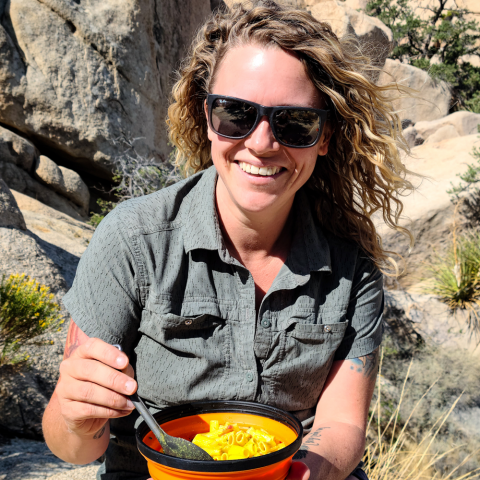Nine months prior to being diagnosed with type 2 diabetes, I attempted a backpacking trip across Catalina Island. I didn’t finish the trip because I was so out of shape, in a tremendous amount of pain from the blisters that covered my feet, and the trail conditions themselves were unsafe for me to finish the adventure.
This was frustrating for me. I wanted to be good at this. I knew I could handle it because I’ve done harder things than take a walk with a backpack on.
I have been an athlete for most of my life; I was a gymnast, dabbled in volleyball, basketball, and track in middle school, All-Star cheerleader, rower on the women’s rowing team at the University of Kansas, and four years as a competitive skydiver. Being active has always been a part of my life. But like a lot of folks, I got dealt a tough hand and spent the 12 years prior to my diagnosis eating everything in sight and drinking like a fish to cope with it all.
When I was diagnosed in September 2017, my doctor told me to start moving my body for 30 minutes every day, clean up my nutrition plan, take meds as prescribed, and manage my stress. I started with a walk around my neighborhood. Each morning, I would walk 30-45 minutes to a canyon down the street, and when that was no longer physically challenging, I graduated to local hiking trails. As I stayed committed to this practice, I was very protective of my morning walks. This was my time to clear my head, experience the sights and sounds of nature around me, and turn inward to reflect on what brought me here, to this moment.
As I spent more time outside, I found my entire mindset shifting. Food was no longer the adventure itself, now it was fuel for the adventures I wanted my body to be able to take me on. I started paying more attention to how the different foods I ate made me feel.
But my physical activity, new nutrition plan, and taking medications as prescribed wasn’t enough to get my blood sugar levels into a healthy range at first. I had to take a look at my stress levels and what was contributing to them.
The answer was clear; my career was the most stressful thing in my life. I am a self-diagnosed workaholic. When I was diagnosed, I was leading email marketing for a major media company while managing a national commercial campaign and internal rebranding exercise. I was at the peak of my career, and I was overcommitted, on the verge of a burnout, and as my diagnosis suggested, slowly working myself to death.
I made the hard choice to leave a successful career in corporate communications to join a friend’s startup. I knew joining a startup would come with its own set of risks, but I couldn’t keep living the way I was prior to my diagnosis. Shortly after joining, I started experiencing near-daily panic attacks, at times twice per day. My blood sugar levels were rising to numbers I hadn’t seen since my initial diagnosis. Something had to give.
I left the startup after 95 days without a backup plan, no other job lined up, no savings to speak of. All I knew was that I had to prioritize my health first and foremost, and my career was preventing me from doing that.
After I quit, I took advantage of my newfound free-time and started hiking more frequently. I realized during a training hike that thanks to diabetes, I had been hiking my feelings instead of eating or drinking them. I was pleased with my progress, but wanted to know why I was eating and drinking my feelings to begin with. And so, I set off on another attempt of the Trans-Catalina Trail to see if I could find the answer.
On the first day, I checked my blood sugar levels. They were perfect. In that moment, I committed to building a life that would allow me to hike as much as possible so I could manage my diabetes effectively. That trip ended up being one of the most transformational experiences of my life, and after I completed it, I set my new plan in motion: hike as much as possible.
Looking back over the course of my life, I knew I was hard-wired for being deeply committed to my career. As soon as I graduated college, I have always prioritized work above everything else. In the next chapter of my life, I decided to use my workaholic nature to my advantage, instead of resisting it. That is how our organization, Hiking My Feelings, was born.
This deep commitment to my health and creating opportunities for other people to experience the healing power of nature has now given me the opportunity to hike thousands of miles around the US, hosting more than 200 events to help folks get off the couch and onto the trail. As long as I make hiking my job, I know I’ll keep showing up for myself.
The mySugr website does not provide medical or legal advice. mySugr blog articles are not scientific articles, but intended for informational purposes only.
Medical or nutritional information on the mySugr website is not intended to replace professional medical advice, diagnosis or treatment. Always consult a physician or health care provider with any questions you may have regarding a medical condition.





